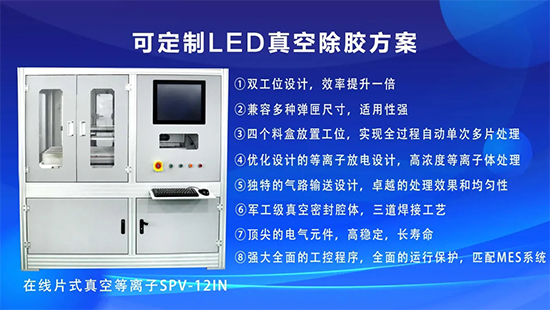Production process of Mini LED
In the Mini LED packaging process, different cleaning processes can be used to achieve ideal results for different pollutants and different substrate and chip materials. However, using the wrong process gas solution will lead to poor cleaning results or even product scrap. For example, if the silver material chip adopts the oxygen plasma process, it will be oxidized and blackened or even scrapped. In general, the particulate pollutants and oxides are cleaned by plasma with a mixture of hydrogen and argon. The gold-plated material chip can use oxygen plasma to remove organic matter, but the silver material chip cannot. Choosing a suitable plasma cleaning process can be roughly divided into the following three aspects in Mini LED packaging:
-
Chip inspection
-
LED expansion
-
Dispensing
Plasma cleaning
-
automatic racking
-
handmade
-
sintering
-
Press welding
Plasma cleaning
-
encapsulation
Plasma cleaning
-
Curing and Post Curing
-
packaging
-
test
-
cutting
1Dispensing
The contaminants on the substrate will cause the silver glue to form a spherical shape, which is not conducive to chip sticking, and is easy to cause damage to the chip when stabbed. Through plasma cleaning, the hydrophilicity of the substrate is greatly improved, which is beneficial to the adsorption of silver glue and chip sticking, and at the same time, the usage of silver glue can be greatly saved, and the cost can be reduced.
2 Press welding
After the chip is pasted on the substrate, after high temperature curing, there are pollutants such as oxides on the substrate. These pollutants cause the welding between the chip and the substrate to be unstable. After plasma cleaning, the bonding strength and the uniformity of the pulling force of the leads are improved, thereby improving the yield.
3 Encapsulation
In the process of epoxy resin injection of LED, contaminants will lead to high bubble rate, resulting in low product quality and service life. After plasma cleaning, the colloid bond is more reliable, effectively reducing the formation of air bubbles, and will also significantly improve the heat dissipation rate and light output rate.
Summarize
By comparing the contact angle data before and after plasma cleaning, it can be seen that the surface activation of the material, the removal of oxides and micro-particle contaminants, can be directly manifested by the tensile strength and wettability of the bonding wires on the surface of the material.
1.png)
